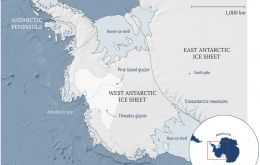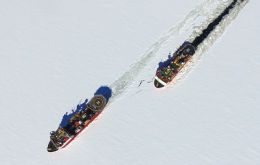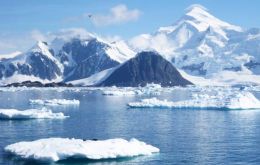MercoPress. South Atlantic News Agency
Tag: West Antarctica
-
Tuesday, October 19th 2021 - 09:00 UTC
Widespread collapse of West Antarctica’s ice sheet is avoidable if we keep global warming below 2℃

By Dan Lowry, Mario Krapp, Te Herenga Waka (*) – Rising seas are already making storm damage more costly, adding to the impact on about 700 million people who live in low-lying coastal areas at risk of flooding. Scientists expect sea-level rise will exacerbate the damage from storm surges and coastal floods during the coming decades. But predicting just how much and how fast the seas will rise this century is difficult, mainly because of uncertainties about how Antarctica’s ice sheet will behave.
-
Wednesday, January 16th 2019 - 09:10 UTC
HMS Protector and RRS Shackleton support 100 scientists researching Antarctica glacier

Royal Navy survey ship HMS Protector smashed through nearly 300 miles of Antarctic ice to help scientists begin a five-year mission to understand how West Antarctica is contributing to global sea-level rise.
-
Tuesday, September 26th 2017 - 18:45 UTC
Jumbo 100sq-miles iceberg breaks off from Pine Island Glacier in West Antarctica

An enormous Antarctic glacier has given up an iceberg over 100 square miles in size, the second time in two years it has lost such a large piece in a process that has scientists wondering if its behavior is changing for the worse.
-
Tuesday, May 20th 2014 - 08:19 UTC
Antarctica ice sheet loss has doubled since 2010, shows CryoSat satellite

The Antarctic ice sheet has lost ice twice as quickly in the past three years as when it was last surveyed between 2005 and 2010, say scientists. Results from the CryoSat-2 satellite mission, published Monday in the journal Geophysical Research Letters, say the largest ice sheet on Earth is now losing 159 billion tons of ice each year.
